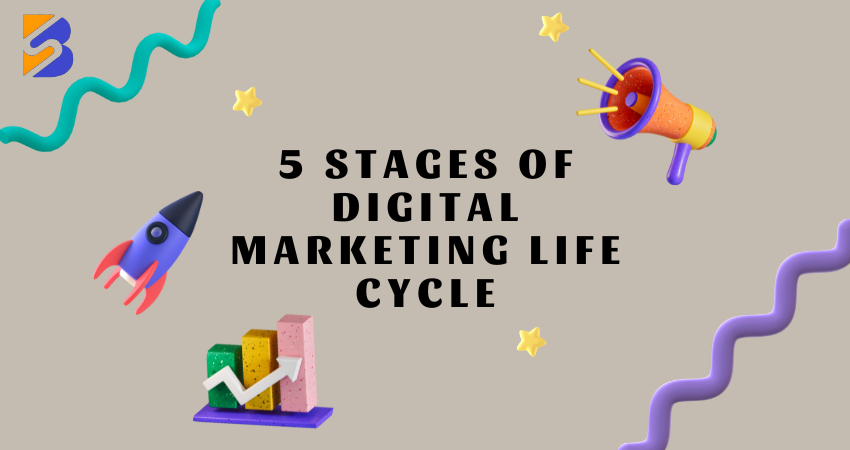Digital marketing follows a distinct life cycle that can help marketers navigate the complexities of the online world. The digital marketing life cycle consists of five stages, each serving a specific purpose in promoting products or services through digital marketing. Each stage builds upon the previous one, creating a continuous loop of growth and improvement.
5 Stages of Digital Marketing Evolution
In this blog, we will discuss into the five stages of the digital marketing life cycle, uncovering the key strategies and actions required at each phase to drive growth and maximize results.
Stage 1: Research and Planning
The journey begins with comprehensive research and planning. This stage involves understanding your target audience, market trends, and competitors. Conduct thorough keyword research, analyze consumer behavior, and identify your unique selling propositions. Develop a solid marketing strategy that aligns with your business objectives and create a detailed plan of action.
In this initial stage, marketers gather information about the audience, industry trends, and competitors. By analyzing customer behavior and preferences, they develop strategies and tactics tailored to the needs of the target audience. This includes identifying key performance indicators (KPIs), defining goals, setting budgets, and choosing appropriate marketing channels.
Stage 2: Implementation and Optimization
Once you have a strategy in place, it’s time to start implementing it. This means creating and publishing content, running ads, and tracking your results. It’s important to be patient and persistent during this stage, as it can take time to see results.
With a well-crafted plan in place, it’s time to put it into action. This stage focuses on executing your digital marketing initiatives across various channels such as search engine optimization (SEO), social media, content marketing, email campaigns, and paid advertising. Monitor and measure the performance of your campaigns using analytics tools to identify areas for improvement and make data-driven optimizations.
Stage 3: Growth and Expansion
As your digital marketing efforts gain traction, it’s essential to focus on growth and expansion. This stage involves scaling your campaigns, increasing your online presence, and exploring new opportunities. Leverage customer feedback, A/B testing, and market insights to refine your strategies and drive further engagement. Embrace emerging technologies and trends to stay ahead of the curve and capture new markets.
This means offering compelling offers, providing excellent customer service, and nurturing your relationships with your customers. You can also expand your reach by targeting new audiences and channels.
Stage 4: Engagement and Relationship Building
Building strong relationships with your target audience is beneficial in digital marketing. This stage revolves around fostering meaningful engagement, nurturing leads, and converting prospects into loyal customers. Implement personalized marketing tactics, leverage marketing automation, and create compelling content that resonates with your audience. Build trust, encourage customer advocacy, and establish your brand as an authority in your industry.
Strengthening customer loyalty and cultivating long-lasting relationships forms an integral part of effective digital marketing. In fact, successful brand interaction leads to higher retention rates and increased revenue. At this point in the digital marketing life cycle, businesses work towards enhancing customer experience, nurturing relationships, and addressing any issues that arise.
Stage 5: Analysis and Adaptation
By now, your digital marketing efforts have been executed consistently over several months, producing valuable insights along the way. It’s crucial to assess these findings, learn from your triumphs and failures, and adapt accordingly.
The final stage of the digital marketing life cycle focuses on continuous analysis and adaptation. Monitor key performance indicators (KPIs), track metrics, and assess the overall effectiveness of your marketing efforts. Identify areas of success and areas that require improvement. Stay agile and adapt your strategies based on market shifts, consumer behavior, and evolving industry trends. Embrace innovation and never stop learning.
Conclusion:
In conclusion, the five stages of the digital marketing lifecycle represent an iterative process that businesses must follow in order to achieve sustained success in today’s competitive online landscape. From building awareness about your brand and products to creating compelling customer experiences and analyzing key performance indicators (KPIs), each stage plays a vital role in achieving your desired outcomes while keeping your customers engaged and satisfied. By integrating automation technologies at various points within this framework, marketers can streamline their efforts, drive efficiency, reduce errors, and improve speed and accuracy without sacrificing creativity or human connection. Ultimately, a well-designed digital marketing strategy combined with intelligent automation solutions offers an ideal pathway toward reaching your goals faster, with less effort and greater precision than ever before. So go ahead, start crafting your own automated journey through the digital marketing lifecycle! The future is waiting.



